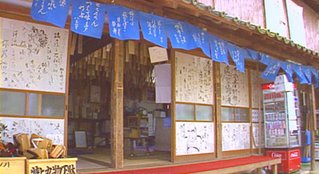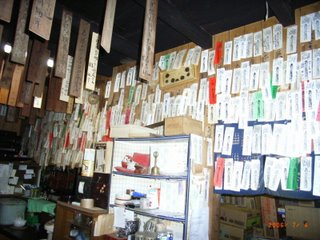:::::::::::::::::::::::::::::::::::::::::::::::::::::::::::::::::::::::::::::::::::::::::::::::::::::::::::::::::::::::::::
Temple 71 : Iyadani-Ji 弥谷寺
四国第71番
弥谷寺参道俳句茶屋
Near the entrance to this temple is the famous "Haiku Teahouse" Haiku Chaya 俳句茶屋。
You can even see some Daruma on the photos. The teahouse, or small restaurant, started more than 100 years ago to cater to the tired pilgrims.

http://www.shokokai-kagawa.or.jp/mino/mino/kankou/haiku.html

http://etuosimomura.cocolog-nifty.com/blog/2006/07/1_0ce8.html
Click HERE to look at more photos !
World Kigo Database : Henro Pilgrims and Haiku
:::::::::::::::::::::::::::::::::::::::::::::::::::::::::::::::::::::::::::::::::::::::::::::::::::::::::::::::::::::::::::
Iyadani-Ji Temple is the 71st stop of the Pilgrimage to 88 Buddhist Temples across Shikoku. High Priest Kukai, is said to have the training in his childhood days in a cave and has old history.
Mount Iyadani was worshipped as the mountain of deceased, and believed that many of the spirits had go back to the mountain in the old days. Inside the temple, there are many ruins related to this legend, some statue and carvings, five-ring tower, are said to go back to Kamakura Period.
The symbol of Iyadaniji Temple is the 370 steep stone steps leading to the main hall. To catch your breath, we recommend the haiku cafe which many haiku poems created by the visitors decorate the room.
In middle of Mount Iyadani lies in a forest, recreation center called Mount Iyadani Fureai No Mori. It is designed for small children to elderly visitors. Fureai Park Mino has accomodation and natural hot spa, Cosmo Land Mino is amusement parks with many rides. Multi-purpose Square, Michi-no-Eki, Herb Garden, Promnade are other features.
Tsushima Shrine, famoust for the guardian of children is nearby, and Tenmu Castle Ruins, Mount Kihouzan Mini-Shikoku 88 Jizo Statues are easy access as well. The town is full of history and culture, and to enjoy and relax.
Iyadani-Ji
:::::::::::::::::::::::::::::::::::::::::::::::::::::::::::::::::::::::::::::::::::::::::::::::::::::::::::::::::::::::::::

- quote
Tsushimanomiya Station (津島ノ宮駅 Tsushimanomiya-eki) is a railway station in Mitoyo, Kagawa Prefecture, Japan. Tsushimanomiya Station opens at August 4 and 5 only, when the nearby Tsushima Shrine (津嶋神社 Tsushima Jinja) has the Great Summer Festival. Excluding temporary closed stations, the station has the shortest opening days in Japan.
© More in the WIKIPEDIA !
Tsushima Jinja 津島神社
- quote
Tsushima no Miya
Tsushima Jinja was primarily seen as offering protection for cattle during the Edo period, after a disease killed much of the cattle in Japan, but left the local animals unscathed. However, in the Taisho period, many parents came to the shrine to pray for their children, seeking to protect them from disease. While that might seem like a bit of a wild connection, is there really that big of a difference between raising calves and raising children?

However, the shrine isn’t open for visitors just any day of the year. If you’re looking for some spiritual protection for your child, you’ll have a very narrow window of time to stop by the shrine each year–like the train station, it’s only accessible to the public during the summer festival on August 4 and 5. We suppose the deity is busy protecting everyone’s children the rest of the year, so it makes sense.
Since the bridge is the only way people can get across without a boat, a simple but clever method is used to deter mischievous youth and other troublemakers from trespassing on the island for the other 363 days a year. They take out the planks!
- source : en.rocketnews24.com
:::::::::::::::::::::::::::::::::::::::::::::::::::::::::::::::::::::::::::::::::::::::::::::::::::::::::::::::::::::::::::
mountain temple visit -
a cup of tea and
a haiku to go
Gabi Greve, 2001
:::::::::::::::::::::::::::::::::::::::::::::::::::::::::::::::::::::::::::::::::::::::::::::::::::::::::::::::::::::::::::
Shikoku Henro 88 Temples 四国遍路88札所
Two short Haiku Henro Trips, Summer 2005
:::::::::::::::::::::::::::::::::::::::::::::::::::::::::::::::::::::::::::::::::::::::::::::::::::::::::::::::::::::::::::
[ . BACK to DARUMA MUSEUM TOP . ]
[ . BACK to WORLDKIGO . TOP . ]
:::::::::::::::::::::::::::::::::::::::::::::::::::::::::::::::::::::::::::::::::::::::::::::::::::::::::::::::::::::::::::








1 comment:
writing
on the wall
haiku temple
Post a Comment